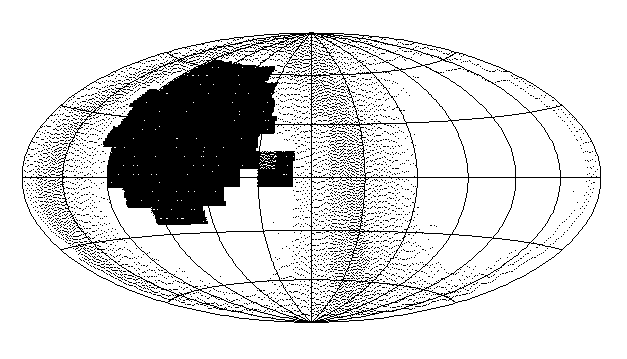 The AXAF Orbits
The AXAF Orbits The AXAF Orbits
The AXAF OrbitsMany of the properties of the AXAF missions are dictated by the orbits occupied by the satellites: a scaled drawing of these orbits in the immediate neighborhood of the earth appears as the graphic in the title block of this article. Although no final selection of the orbits has been made, it is possible to make some general remarks about the types of constraints that they might impose on observations with AXAF-I and AXAF-S.
The baseline AXAF-I orbit is elliptical, with initial semi-major axis 55,000 km, eccentricity 0.818, inclination 28.5deg, and ascending node at right ascension 240deg. The perigee of this orbit (10,000 km) lies well inside the radiation belts, while the apogee distance of 100,000 km is an appreciable fraction of the distance to the Moon. Over the mission lifetime the orbit gradually becomes more circular (under the combined gravitational effects of the Sun, Moon, and Earth), the orbital semi-major axis and inclination change slightly, and the orbit precesses slowly.
At any one time some parts of the sky will be unavailable for observation because they lie too close to the Moon, the Sun, or the bright Earth. For example, six months after launch (scheduled for September 1998) the visibility function for the sky appears as shown in Figure 1. In this diagram (which represents the average visibility function for the sky over two 35.6-hour orbits) the lightest regions are visible for 72% of the spacecraft orbit (where data are assumed to be taken only during the period that AXAF-I is at geocentric distance > 60,000 km, when the radiation background is low), while the darker regions cannot be observed because of their proximity to the Sun, Moon, or Earth. Observers with sources that lie out of the ecliptic plane can benefit from the long continuous integrations (up to 92.6 ks) that are possible. Sources near the ecliptic plane are observable only under favorable configurations of the Sun and Moon, and provided that the plane of the orbit has not precessed to a `bad' right ascension, when the Earth blocks the viewing direction while the satellite is above the radiation belts. Thus regions of the sky near (5h,+30deg) and (20h,+30deg) are unobservable at the dates represented by Figure 1.
It is still possible that AXAF-I will be launched into a near-circular orbit with radius ~60,000 km, rather than the elliptical orbit described above. If this is the case, then AXAF-I remains above the radiation belts for the entire orbit, so that the peak viewing efficiency on the sky rises to nearly 100%, a larger fraction of the sky can be seen on any one orbit, and very long continuous observations become possible.
The baseline AXAF-S orbit is circular, with an initial altitude of 635 nautical miles (semi-major axis 7014 km), an orbital inclination of 97.9deg, and with the ascending node at right ascension 90deg. This orbit is sun-synchronous, and subject to the effects of the South Atlantic Anomaly (SAA) during some intervals.
Averaged over two representative orbits a few months after launch (currently scheduled for December 1999), and when the satellite is not strongly affected by the SAA, the visibility function for the sky is as shown in Figure 2. The best regions for observation are those that lie in the anti-solar hemisphere ((~16h,~0deg), in Fig. 2), but normally the viewing directions are expected to lie in a region within +/-20deg of the orbital plane (which corresponds to the grey great circle that passes through ((22.5h,0deg) on Fig. 2), so that only 50-60% of each orbit is likely to provide useful data, and the maximum continuous duration of an observation segment will be substantially less than the 98-minute orbital period. Care must be taken in the choice of sources for simultaneous observation with AXAF-S and ground-based observatories because of the rapidly-varying visibility of most of the sky.
It is anticipated that visualization tools for the orbits will be provided to allow time-critical observations to be evaluated by prospective users of AXAF-I and AXAF-S, based on predictions for the satellite orbits during the coming scheduling periods. The appearance and use of these tools have not yet been defined, and input from prospective users of the satellites is warmly solicited.

Figure 1. The visibility function for the sky in equatorial coordinates for AXAF-I averaged over two of its 35.6-hour orbits about two months after launch. The coordinate grid is drawn at intervals of 2h in RA and 30deg in dec, with (0h,0deg) at the center, (0h,+90deg) at the top, (2h,0deg) to the left of center, and (22h,0deg) to the right of center. The grey scale indicates the fraction of time that the satellite may be used to observe in a given direction, running from dark ( < 10% of time available) to light (> 70% of time available). The large dark forbidden region near (5h,+30deg) is caused by the presence of the Sun, the Earth is an important obstruction near (20h,+30deg) (and less important in other parts of its path across AXAF-I's sky), and the small region near (17h,-10deg) is caused by the Moon.

Figure 2. Same as Fig. 1, but for two of the 98-minute orbits of AXAF-S about two months after launch. The large dark forbidden region near (5h,+20deg) is caused by the presence of the Sun, while the Moon appears near (1h,0deg), and the orbital plane (which is partially obscured by the Earth) can be seen as a grey great circle. The restriction to a `normal observing zone' within +/-20deg of the orbital plane has not been taken into account in this diagram since observations outside this region are permitted.
eshepard@asc.harvard.edu